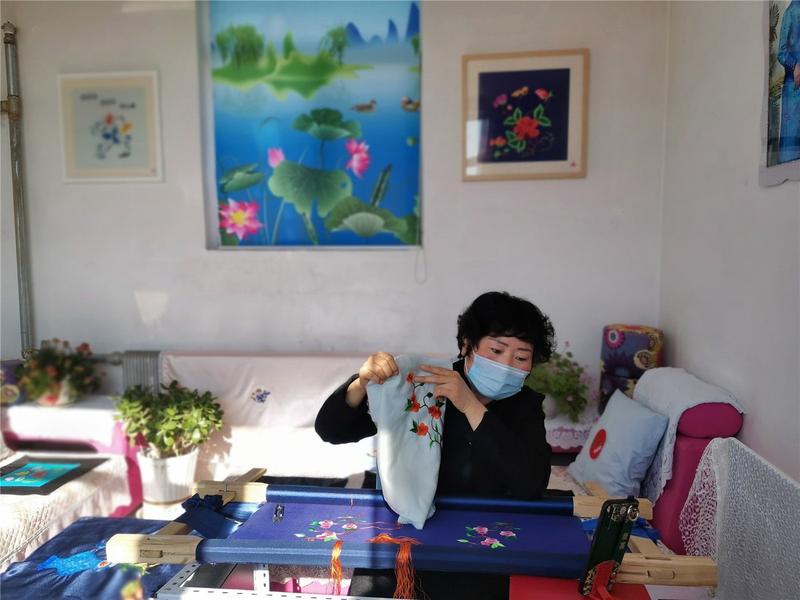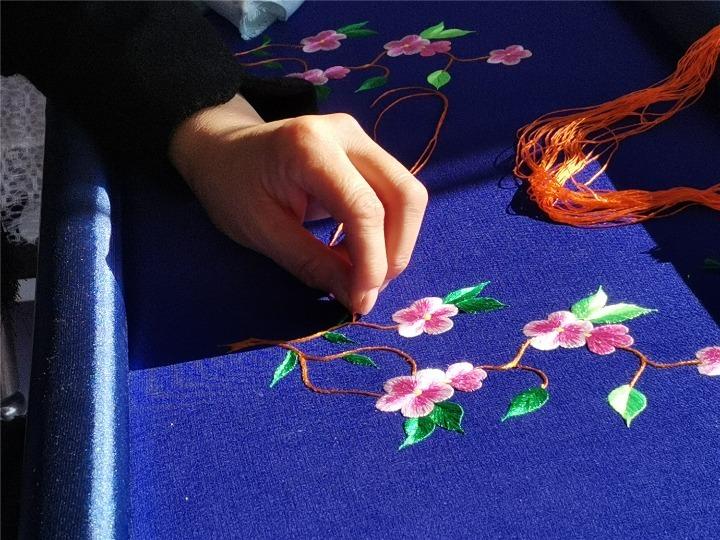 Wang Jinlian, a poor villager from the prefecture-level Hinggan League, Inner Mongolia autonomous region, does the stitching work from home after the novel coronavirus outbreak affected the workshop's operations. (PHOTO / XINHUA)
Wang Jinlian, a poor villager from the prefecture-level Hinggan League, Inner Mongolia autonomous region, does the stitching work from home after the novel coronavirus outbreak affected the workshop's operations. (PHOTO / XINHUA)
HOHHOT-After a long break for the Lunar New Year holiday, Wang Jinlian returned to work, not in the embroidery workshop of her employer, but at home.
Wang, a poor villager from the prefecture-level Hinggan League, Inner Mongolia autonomous region, is one of 1,000 farmers and herders hired by a local embroidery workshop as part of the region's poverty alleviation efforts.
We discuss the details over the phone, and have a special person to pick up our embroideries
Wang Jinlian, a poor villager from the prefecture-level Hinggan League
The embroiderers now do the stitching work from home, after the novel coronavirus outbreak affected the workshop's operations.
"We discuss the details over the phone, and have a special person to pick up our embroideries," Wang said, adding that they had to work overtime to finish an order worth 3 million yuan (US$430,000) on time.
By March 3, Inner Mongolia had no new reports of novel coronavirus cases for two weeks. The region lowered its emergency response on Feb 25. As positive signs start emerging in the battle against the epidemic, the target of eradicating absolute poverty by the end of the year is getting back on track.
 Wang Jinlian, a poor villager from the prefecture-level Hinggan League, Inner Mongolia autonomous region, does the stitching work from home after the novel coronavirus outbreak affected the workshop's operations. (PHOTO / XINHUA)
Wang Jinlian, a poor villager from the prefecture-level Hinggan League, Inner Mongolia autonomous region, does the stitching work from home after the novel coronavirus outbreak affected the workshop's operations. (PHOTO / XINHUA)
By the end of last year, there were still over 5.5 million people living below the poverty line nationwide.
Yao Yongbo, director of the regional poverty alleviation office, said the epidemic had hindered the operations of more than 200 of the region's anti-poverty projects, affecting the incomes of more than 7,400 poor villagers.
ALSO READ: Xi stresses overcoming epidemic impact in poverty fight
"The projects, mostly labor-intensive businesses, were suspended because the employees were not allowed to gather in the workshops, and they also lacked raw materials and orders," Yao said.
He said the office had guided the businesses to solicit materials and orders online, and organized online training for the villagers to prepare for the resumption of operations.
The local government also subsidized companies to ensure the provision of agricultural supplies for the upcoming spring plowing.
Bai Enze, manager of an agricultural company called Hexing, said with the support of the government, the company cut the prices of agricultural supplies by 15 percent and offered farmers free soil tests to optimize their fertilizer formula.
The company planned to raise the price of corn by 40 yuan (US$5.70) per metric ton. That would give every impoverished household an additional 1,600 yuan of income this year, Bai said.
READ MORE: China's No. 1 central document prioritizes poverty relief
Low-interest loans were provided to 184 major agricultural and husbandry companies, with the operation resumption rate of the major companies at the prefectural level or above reaching 70 percent, said Wang Yufeng, a spokesman with the regional agricultural and husbandry department.
Support was also emphasized for slaughtering, animal feed, pesticides and agricultural products processing companies, Wang said.


